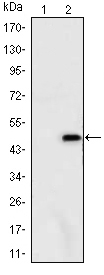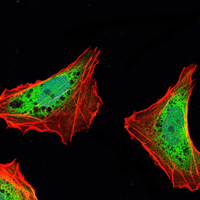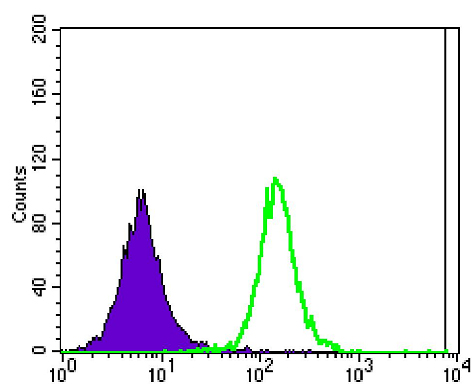Ataxin-1 Monoclonal Antibody
- 货号:YM0051
- 应用:WB;IHC;IF;FCM;ELISA
- 种属:Human
- 简介:
- >>Notch signaling pathway;>>Spinocerebellar ataxia;>>Pathways of neurodegeneration - multiple diseases
- 免疫原:
- Purified recombinant fragment of human Ataxin-1 expressed in E. Coli.
- 特异性:
- Ataxin-1 Monoclonal Antibody detects endogenous levels of Ataxin-1 protein.
- 组成:
- Liquid in PBS containing 50% glycerol, 0.5% BSA and 0.02% sodium azide.
- 稀释:
- WB 1:500 - 1:2000. IHC 1:200 - 1:1000. IF 1:200 - 1:1000. Flow cytometry: 1:200 - 1:400. ELISA: 1:10000. Not yet tested in other applications.
- 纯化工艺:
- Affinity purification
- 储存:
- -15°C to -25°C/1 year(Do not lower than -25°C)
- 其他名称:
- ATXN1;ATX1;SCA1;Ataxin-1;Spinocerebellar ataxia type 1 protein
- 背景:
- ataxin 1(ATXN1) Homo sapiens The autosomal dominant cerebellar ataxias (ADCA) are a heterogeneous group of neurodegenerative disorders characterized by progressive degeneration of the cerebellum, brain stem and spinal cord. Clinically, ADCA has been divided into three groups: ADCA types I-III. ADCAI is genetically heterogeneous, with five genetic loci, designated spinocerebellar ataxia (SCA) 1, 2, 3, 4 and 6, being assigned to five different chromosomes. ADCAII, which always presents with retinal degeneration (SCA7), and ADCAIII often referred to as the `pure' cerebellar syndrome (SCA5), are most likely homogeneous disorders. Several SCA genes have been cloned and shown to contain CAG repeats in their coding regions. ADCA is caused by the expansion of the CAG repeats, producing an elongated polyglutamine tract in the corresponding protein. The expanded repeats are variable in size and unstable, usually increasing in size when transmitted
- 功能:
- alternative products:At least 2 isoforms are produced,disease:Defects in ATXN1 are the cause of spinocerebellar ataxia type 1 (SCA1) [MIM:164400]; also known as olivopontocerebellar atrophy I (OPCA I or OPCA1). Spinocerebellar ataxia is a clinically and genetically heterogeneous group of cerebellar disorders. Patients show progressive incoordination of gait and often poor coordination of hands, speech and eye movements, due to cerebellum degeneration with variable involvement of the brainstem and spinal cord. SCA1 belongs to the autosomal dominant cerebellar ataxias type I (ADCA I) which are characterized by cerebellar ataxia in combination with additional clinical features like optic atrophy, ophthalmoplegia, bulbar and extrapyramidal signs, peripheral neuropathy and dementia. SCA1 is caused by expansion of a CAG repeat in the coding region of ATXN1. Longer expansions result in earlier
- 细胞定位:
- Cytoplasm . Nucleus . Colocalizes with USP7 in the nucleus. .
- 组织表达:
- Widely expressed throughout the body.

- Western Blot analysis using Ataxin-1 Monoclonal Antibody against HEK293 (1) and ATXN1-hIgGFc transfected HEK293 (2) cell lysate.

- Immunohistochemistry analysis of paraffin-embedded ovarian cancer tissues (left) and lung cancer tissues (right) with DAB staining using Ataxin-1 Monoclonal Antibody.

- Immunofluorescence analysis of NTERA-2 cells using Ataxin-1 Monoclonal Antibody (green). Blue: DRAQ5 fluorescent DNA dye. Red: Actin filaments have been labeled with Alexa Fluor-555 phalloidin.

- Flow cytometric analysis of Jurkat cells using Ataxin-1 Monoclonal Antibody (green) and negative control (purple).







